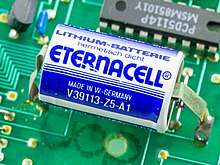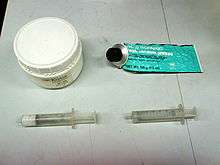Hermetic seal
A hermetic seal is any type of sealing that makes a given object airtight (preventing the passage of air, oxygen, or other gases). The term originally applied to airtight glass containers, but as technology advanced it applied to a larger category of materials, including rubber and plastics. Hermetic seals are essential to the correct and safe functionality of many electronic and healthcare products. Used technically, it is stated in conjunction with a specific test method and conditions of use.
Etymology
The word hermetic comes from the Greek god Hermes, via the vocabulary of alchemy. The alchemists invented a process for making an airtight glass tube, which they used for distillation. The process used a secret seal, whose invention was attributed to an inspiration of alchemy, Hermes Trismegistus.
Uses

Some kinds of packaging must maintain a seal against the flow of gases, for example, packaging for some foods, pharmaceuticals, chemicals and consumer goods. The term can describe the result of some food preservation practices, such as vacuum packing and canning. Packaging materials include glass, aluminum cans, metal foils, and gas impermeable plastics.
Some buildings designed with sustainable architecture principles may use airtight technologies to conserve energy. Under some low energy building, passive house, low-energy house, self-sufficient homes, zero energy building, and superinsulation standards, structures must be more air-tight than other lesser standards. Air barriers are not effective if construction joints or service penetrations (holes for pipes, etc.) are not sealed. Airtightness is a measure of the amount of warm (or cool) air that can pass through a structure. Mechanical ventilation system can recover heat before discharging air externally. Green buildings may include windows that combine triple-pane insulated glazing with argon or krypton gas to reduce thermal conductivity and increase efficiency. In landscape and exterior construction projects, airtight seals may be used to protect general services and landscape lighting electrical connections/splices. Airtight implies both waterproof and vapor-proof.
Applications for hermetic sealing include semiconductor electronics, thermostats, optical devices, MEMS, and switches. Electrical or electronic parts may be hermetic sealed to secure against water vapor and foreign bodies to maintain proper functioning and reliability.
Hermetic sealing for airtight conditions is used in archiving significant historical items. In 1951, The U.S. Constitution, U.S. Declaration of Independence, and U.S. Bill of Rights were hermetically sealed with helium gas in glass cases housed in the U.S. National Archives in Washington, D.C.. In 2003, they were moved to new glass cases hermetically sealed with argon.[1]
Types of epoxy hermetic seals
Typical epoxy resins have pendant hydroxyl (-OH) groups along their chain that can form bonds or strong polar attractions to oxide or hydroxyl surfaces. Most inorganic surfaces—i.e., metals, minerals, glasses, ceramics—have polarity so they have high surface energy. The important factor in determining good adhesive strength is whether the surface energy of the substrate is close to or higher than the surface energy of the cured adhesive.
Certain epoxy resins and their processes can create a hermetic bond to copper, brass, or epoxy itself with similar coefficients of thermal expansion, and are used in the manufacture of hermetic electrical and fiber optic hermetic seals. Epoxy hermetic seal designs can be used in hermetic seal applications for low or high vacuum or pressures, effectively sealing gases or fluids including helium gas to very low helium gas leak rates similar to glass or ceramic. Hermetic epoxy seals also offer the design flexibility of sealing either copper alloy wires or pins, instead of the much less electrically conductive Kovar pin materials required in glass or ceramic hermetic seals. With a typical operating temperature range of -70°C to +125°C or 150°C, epoxy hermetic seals are more limited in comparison to glass or ceramic seals, although some hermetic epoxy designs are capable of withstanding 200°C.
Types of glass-to-metal hermetic seals
When the glass and the metal being hermetically sealed have the same coefficient of thermal expansion, a "matched seal" derives its strength from bond between the glass and the metal's oxide. This type of glass-to-metal hermetic seal is the weaker of the two types and is generally used for low-intensity applications such as in light bulb bases.[2]

"Compression seals" occur when the glass and the metal have different coefficients of thermal expansion such that the metal compresses around the solidified glass as it cools. Compression seals can withstand very high pressure and are used in a variety of industrial applications.
Compared to epoxy hermetic seals, glass-to-metal seals can be operated up to much higher temperatures (250 °C for compression seals, 450°C for matched seals). The material selection is however more limited due to thermal expansion constraints. The sealing process is performed at roughly 1000 °C in an inert or reducing atmosphere to prevent discoloration of the parts.[3]
Ceramic-to-metal hermetic seals
Co-fired ceramic seals are an alternative to glass. Ceramic seals exceed the design barriers of glass to metal seals due to superior hermetic performance in high stress environments requiring a robust seal. Choosing between glass versus ceramic depends on the application, weight, thermal solution and material requirements.
Glassware sealing
Sealing solids
Glass taper joints can be sealed hermetically with PTFE sealing rings (high vacuum tight, air leakage rate 10−6 mBar*L/sec and below),[4] o-rings (optionally encapsulated o-rings), or PTFE sleeves,[5] sometimes used instead of grease that can dissolve into contamination. PTFE tape, PTFE resin string, and wax are other alternatives that are finding widespread use, but require a little care when winding onto the joint to ensure a good seal is produced.
Grease

A thin layer of grease made for this application can be applied to the ground glass surfaces to be connected, and the inner joint is inserted into the outer joint such that the ground glass surfaces of each are next to each other to make the connection. In addition to making a leak-tight connection, the grease lets two joints be later separated more easily. A potential drawback of such grease is that if used on laboratory glassware for a long time in high-temperature applications (such as for continuous distillation), the grease may eventually contaminate the chemicals.[6] Also, reagents may react with the grease,[7][8] especially under vacuum. For these reasons, it is advisable to apply a light ring of grease at the fat end of the taper and not its tip, to keep it from inside the glassware. If the grease smears over the entire taper surface on mating, too much was used. Using greases specifically designed for this purpose is also a good idea, as these are often better at sealing under vacuum, thicker and so less likely to flow out of the taper, become fluidic at higher temperatures than Vaseline (a common substitute) and are more chemically inert than other substitutes.
Cleaning
Ground glass joints are translucent when physically free of debris and clean. Solvents, reaction mixtures, and old grease show up as transparent spots. Grease can be removed by wiping with an appropriate solvent; ethers, methylene chloride, ethyl acetate, or hexanes work well for silicone- and hydrocarbon-based greases. Fluoroether-based greases are quite impervious to organic solvents. Most chemists simply wipe them off as much as possible. However, some fluorinated solvents can remove fluoroether greases, but are more expensive than laboratory solvents.
Testing
Standard test methods are available for measuring the moisture vapor transmission rate, oxygen transmission rate, etc. of packaging materials. Completed packages, however, involve heat seals, joints, and closures that often reduce the effective barrier of the package. For example, the glass of a glass bottle may have an effective total barrier but the screw cap closure and the closure liner might not.
See also
| Look up hermetic seal in Wiktionary, the free dictionary. |
Notes
- "Origins of the Charters of Freedom Project". 2001-06-25. Retrieved 2015-11-07.
- "Hermetic Seal | Glass-to-Metal Seal | Elan Technology in USA". Elan Technology. Retrieved 2015-12-03.
- "Glass-to-Metal Sealing Technology | Dietze Group". Dietze Group. Retrieved 2019-07-01.
- Glindemann, D., Glindemann, U. (2001). “Greaseless Taper Jointed Glassware and Containers hermetic tight with new PTFE Sealing Ring”. Fusion (ASGS) 48 (2): 29-33.
- Loughborough Glass Co., Ltd. (1957). "Sleeves to replace grease in ground glass joints". Journal of Scientific Instruments. 34: 38. Bibcode:1957JScI...34...38L. doi:10.1088/0950-7671/34/1/429.
- Rob Toreki (2006-12-30). "Glassware Joints". Interactive Learning Paradigms Inc.
- Haiduc, I., "Silicone Grease: A Serendipitous Reagent for the Synthesis of Exotic Molecular and Supramolecular Compounds", Organometallics 2004, volume 23, pp. 3-8. doi:10.1021/om034176w
- Lucian C. Pop and M. Saito (2015). "Serendipitous Reactions Involving a Silicone Grease". Coordination Chemistry Reviews. doi:10.1016/j.ccr.2015.07.005.